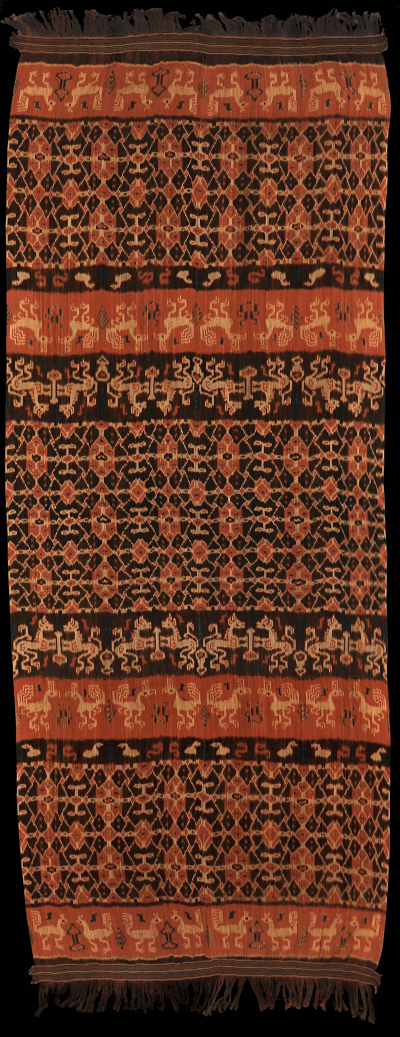| |
 
 | | | |
027 Sumba, East Sumba
Hinggi (men's blanket)  
| | Locale: | Probably Kambera or Rende. | | Period: | 1920-1940 | | Yarn: | Cotton, hand-spun, medium | | Technique: | Warp ikat | | Panels: | 2 | | Size: | 104 x 269 cm (3' 4" x 8' 9") LW: 2.59 | | Design: | The classical lay-out with eleven patterned areas often seen in older hinggi. Three wide bands of patola ratu pattern, to Sumbanese evoking the spotted skin of a python. A band with patola ratu in the kundu duku, the central section meant to be worn over the shoulder, is rather typical for hinggi made for royalty, but here it is unusually wide. The addition of two more panels adds prestige. Two narrower bands show mounting lions and sceptres, four morinda red bands show cream coloured horses, all traditional symbols of wealth in Sumbanese society. | | Comment: | Mounting lions are a motif adapted by the Sumbanese ruling class from Dutch heraldry. The three fields with geometric designs called patola ratu are derived from patola trade cloths, and are likewise a sign of royalty. The dappled effect of the patola ratu pattern is reminiscent of python skin and is a symbol of regeneration, since the python sheds its skin and can be 'reborn'. Excellent, tight weaving, warm brick red tone, and several areas where overdyeing of morinda with indigo, called belapit, has created a purplish brown tone. An older hinggi from a good house. | | Background: | Chapters on Sumba and East Sumba. | | Exhibited: | Museu do Oriente, Lisbon, 2014/15. | | Published: | Woven Languages, 2014.
Noble Virtuosity: Hidden Asymmetry in Ikat from Sumba, 2024. | | Compare: | 160 171 015 | | Sources: | Very similar to hinggi depicted in Khan Majlis, Woven Messages, Fig. 209. Also similar to Fig. 210, 212. Cf. also University of Leeds International Textile Archive, Inv. No. 2010.411; and Gillow, Traditional Indonesian Textiles, Fig. 6. Probably made in same village as hinggi in Brinkgreve and Stuart-Fox, Living with Indonesian Art, Fig. 308, which has different layout but has the same tonality and uses same and similar motifs in other spatial arrangement. From old Dutch collection. | | |

©Peter ten Hoopen, 2025
All rights reserved.
|
|


